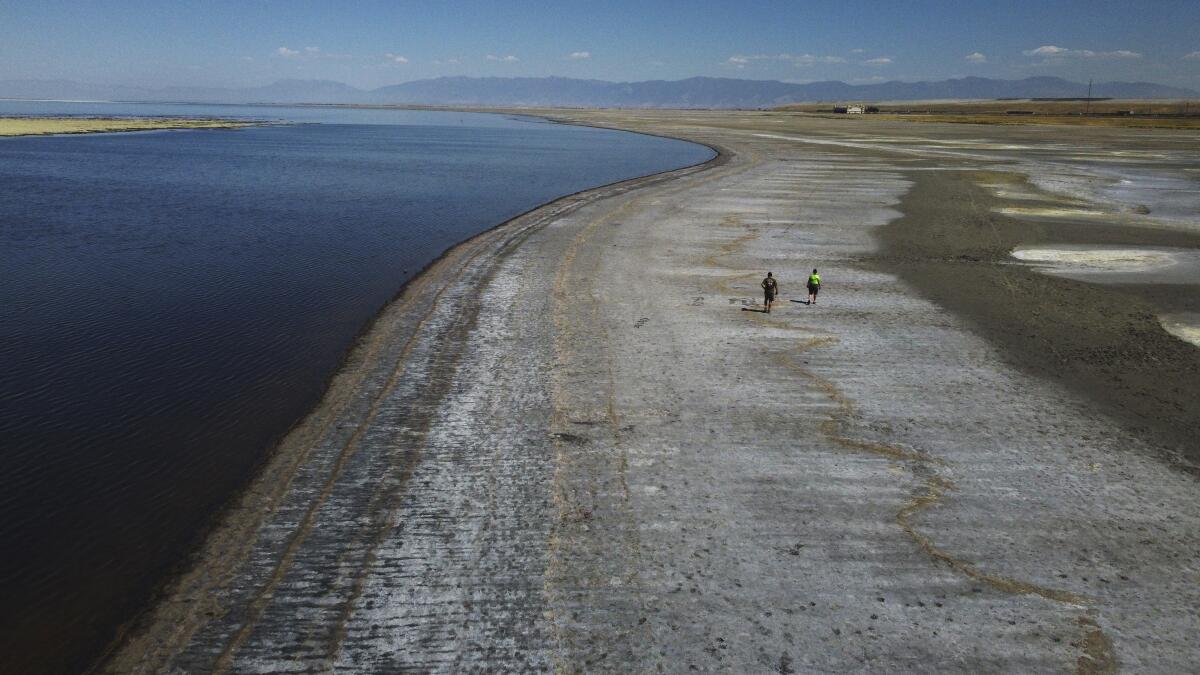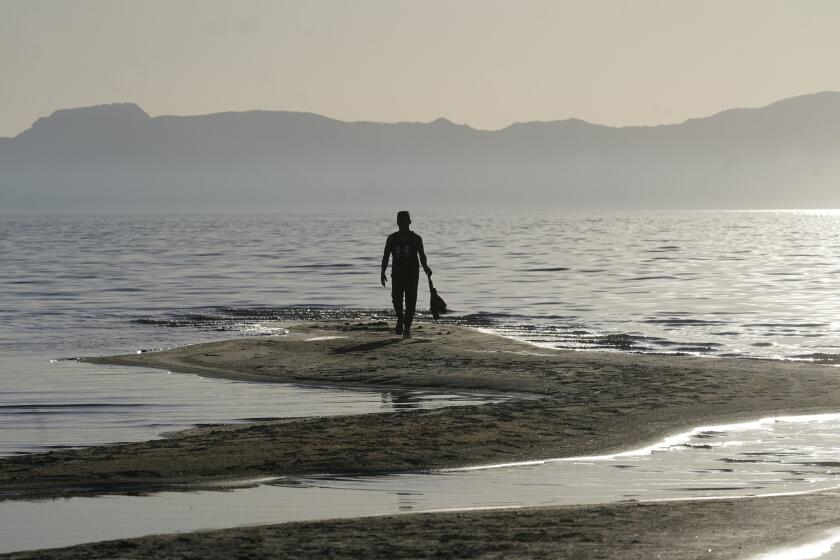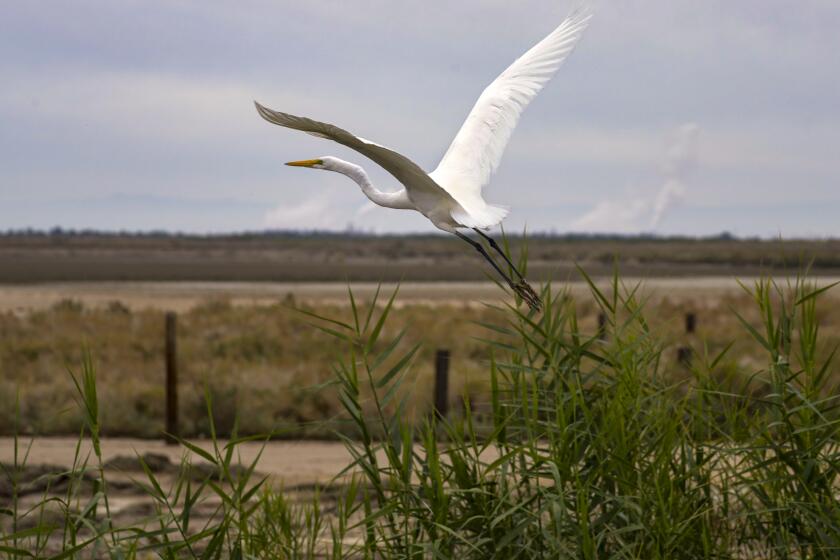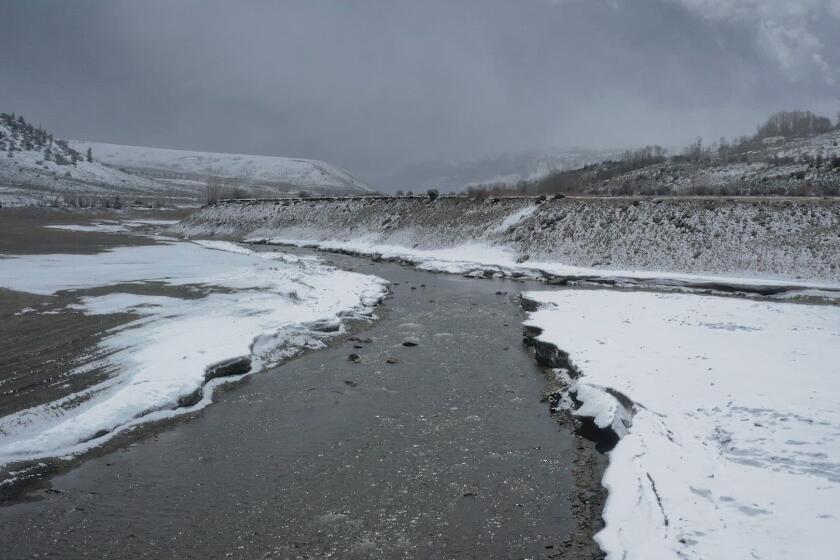Opinion: The Great Salt Lake is disappearing. Utah has 45 days to save it

We often describe the stillness and quiet of the desert as timeless. But deserts are dynamic and desert lakes fragile, none more so than Utah’s Great Salt Lake.
Emblematic of the West’s Great Basin, the Great Salt Lake has no outlet. The lake can only hold its own against evaporation if sufficient water arrives from three river systems fed by mountain snowmelt. When inflow decreases, the lake recedes. Each year since 2020, the Great Salt Lake received less than a third of its average (since 1850) stream flow. The lake level fell to the lowest surface elevation ever recorded, 4,188 feet above sea level, in November 2022.
The crisis is real. The Great Salt Lake is disappearing.
This largest saltwater lake in the Western Hemisphere is essentially a shallow saucer, with an average depth of just under 15 feet. Every one-foot drop in surface level matters. By the end of last year, the lake had lost 73% of its water and 60% of its area, exposing more than 800 square miles of lakebed sediments dense with heavy metals and organic pollutants.
A group of 31 concerned scientists and conservationists issued a call to arms on Jan. 4. Without emergency action to double the lake’s inflow, it could be gone in five years.
Settlers in Utah who have lived with the Great Salt Lake for 170 years have mostly taken the iconic “briny shallow” and its fiery sunsets for granted, a given in the state’s landscape and resources. The lake and its wetlands yield minerals, thousands of jobs, and an annual $2.5 billion for the Utah economy. Its brine shrimp eggs are used worldwide as food for farmed fish and shrimp, providing crucial calories for millions of people. The lake suppresses windblown toxic dust, boosts precipitation of incoming storms through the “lake effect,” and supports 80% of Utah’s wetlands — critical habitat for globally significant populations of migratory birds.
The Great Salt Lake in Utah has been shrinking for years, and a drought gripping the Western U.S. could make this year the worst yet.
All these wonders do best with a minimum healthy surface elevation of about 4,200 feet, which the Great Salt Lake hasn’t seen for 20 years. And while this winter’s atmospheric rivers brought record precipitation that raised the lake by a foot, water diversions have continued unabated. A drying and warming climate will increase evapotranspiration and decrease stream flow, but it is irrigated agriculture that has created our current crisis.
As the lake shrinks, it grows saltier, now measuring 19% salinity (six times as salty as the ocean), well past the 12% salinity favored by two crucial food chains in the lake. Algae feed the brine shrimp; mats of cyanobacteria growing on mounds called microbialites nourish brine flies. More than 10 million migratory birds, in turn, feast on these shrimp and flies.
Each of the migrating 5 million eared grebes that return to the lake each year eats 30,000 brine shrimp a day — for months. Half of the world’s population of Wilson’s phalaropes depends on the lake’s brine flies and midge larvae to take on fat reserves for their 3,400-mile nonstop migration to South America. Without the lifeline of the lake and its resources, these birds can’t survive their migration.
The shrimp and flies haven’t disappeared yet, but the retreating lake has beached the microbialite mounds “like tombstones,” in Bonnie Baxter’s words. That spells famine for the phalaropes. In the summer of 2022, Baxter, director of the Great Salt Lake Institute at Salt Lake City’s Westminster College, encountered no adult brine flies and no birds on the shores of the lake’s Antelope Island, now a peninsula because of low water levels. She should have seen hovering clouds of the insects. “We’re seeing this system crash before our eyes,” Baxter says, with sorrow.
A total collapse in food-chain resources could lead to Endangered Species Act listing for any of these species at risk. Such a listing would have an immeasurable impact on water management in northern Utah, with federal intervention in every proposed project that might affect stream flows and aquifer recharge.
These facts have caught the attention of Washington and Utah politicians.
California’s largest lake is shrinking. It can’t be refilled, but it can be saved.
President Biden signed the Saline Lake Ecosystems act in December, providing $25 million to study and monitor vulnerable salt lakes across the Intermountain West. Such funding is welcome, but the lake needs water, not studies — about 2 million acre-feet arriving each year.
Because Utah manages its own water, it is finally up to the state Legislature to save the lake. We can’t legislate weather or climate. But we can pass mandates and incentives to reduce water use, especially by agriculture, which accounts for two-thirds of diversions in the Great Salt Lake watershed.
Nearly 70% of water used by Utah farmers goes to raising alfalfa hay — a water-intensive crop that adds just 0.2% to the state’s gross domestic product. Nearly all that water is unmetered; farmers have no financial incentive to conserve. As for household consumption, Utahns use the most domestic water per capita in the Southwest and pay the least for their water of any state.
Some legislators dream of fixes that won’t involve cutbacks: tree-thinning in mountain forest that might increase runoff, cloud-seeding, pipelines. None of these will suffice, according to water experts.
Colorado River in Crisis is a series of stories, videos and podcasts in which Los Angeles Times journalists travel throughout the river’s watershed, from the headwaters in the Rocky Mountains to the river’s dry delta in Mexico.
Significant legislation and creative funding ideas are coming from both Democrats and Republicans. One proposal would divert sales tax money to compensate ranchers and farmers who let fields go fallow. A proposed Great Salt Lake Authority would centralize management. Grants for high-tech “agriculture optimization” could decrease farmers’ water use by 30%. Modernizing water rights law could keep water in streams and deliver more inflow to the lake.
The Utah Legislature began its 2023 session on Jan. 17. Its members have 45 days until the end of the session on March 3 to take action to save the Great Salt Lake from collapse. Scientists say waiting another year will be too late for the lake to recover. Brigham Young University ecologist Ben Abbott, lead author of the scientists’ call to arms, sums up the challenge: “We’ve got to act now. Unlike politicians, hydrology doesn’t negotiate.”
Record snowfall blanketed the Wasatch Mountains above Salt Lake City this winter. But a single year’s anomalous change in weather can’t alter one stark fact: Utah is — and will remain — the second-driest state in the nation.
Utah must come to grips with its arid heart.
Stephen Trimble lives in Salt Lake City. A 35th anniversary update of his book “The Sagebrush Ocean: A Natural History of the Great Basin” will be published next year.
More to Read
A cure for the common opinion
Get thought-provoking perspectives with our weekly newsletter.
You may occasionally receive promotional content from the Los Angeles Times.













